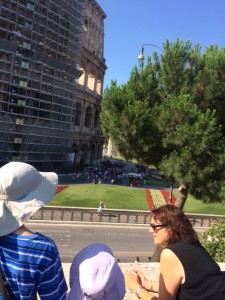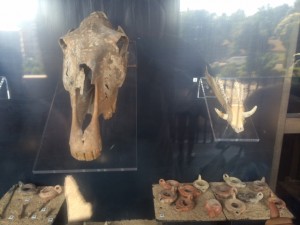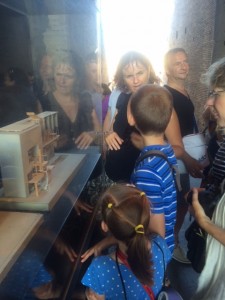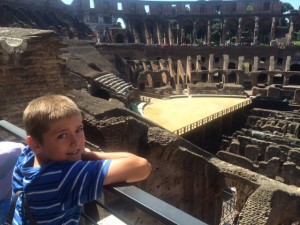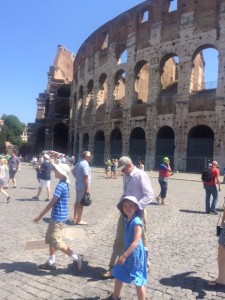Today we went to the Colosseum in Rome with our family tour guide Liz, who is an architect originally from the US but now living in Rome. The Colosseum is an amphitheater, like others we’ve seen in Arles, France, and Pompeii, only bigger–it’s the biggest one in the Roman Empire. It got its name from the huge statue of Nero (Colossus) that Nero ordered be made in his own honor (yeah, he was kind of stuck-up). He wanted to be venerated as the Sun god. The statue was 30 meters in height and was called the Colossus. The location around the statue gradually took on the name “Colosseum” (area around the Colossus) and when the statue was moved the name stuck and was applied to the Colosseum.
The Colosseum was built around the same time as the Judean wars and the destruction of Jerusalem, and captives from those wars actually were the slave labor that built the Colosseum.
We went inside the Colosseumand learned about the gladiators who fought there in the arena. They had a training area close by and a tunnel that went from that training area to the arena. They got their name from the kind of short sword they would use in the arena, which was called a gladius. Also we learned that special gladiators fought with animals, and we even saw some of the bones that have been found from those animals, including skulls of horse, bear, and bones from ostriches, leopards, lions, wild boars, and deer. (They also found some chicken bones, but I think that was probably leftovers from somebody’s lunch.)
Gladiators were forced to perform, as they were slaves, and they had sponsors. If they survived long enough they might win their freedom, but there was no guarantee. Also, if somebody desperately needed money to support their family, they could be a gladiator for a period of time and if they survived, could get some money for doing it. There were some women gladiators and they fought with midget men gladiators.
If you were a middle level status person in Rome, you would be seated in the middle section. If you were a really good friend of the emperor, you’d get a special section up front, with cushions, catered food, and music. (Kind of like the club section at Seahawks and Sounders games today.) Women and girls were seated at the very top. At a certain age boys could sit with their fathers.
The arena games were very violent and gory and thousands of people and animals lost their lives over the years. The tradition started as part of the funeral practices that occurred in ancient Rome. After a number of years that turned into a public spectacle for entertainment. As many as 50,000 to 80,000 people could be seated.
The Colosseum is still used today, but for a very different purpose . Once a year on Good Friday the Pope leads a service there of the stations of the cross.
If you go to Rome I recommend going to the Colosseum. And IF you go, I can recommend an awesome GELATERIA nearby. (A gelateria is a place that serves gelato–the Italian version of ice cream–which I always find refreshing on a hot summer’s day.)

